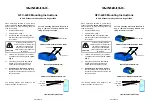
xvi
Confidential
Legal limitations for copying
Observe all copyright laws when using this product.
Color reproductions of certain documents are illegal and may result in either criminal or civil
liability. This memorandum is intended to be a guide rather than a complete listing of every
possible prohibition. In case of doubt, we suggest that you check with counsel as to any
particular questionable documents.
The following documents issued by the United States/Canadian Government or any of its
Agencies may not be copied:
• Money
• Bonds or other certificates of indebtedness
• Certificates of Deposit
• Internal Revenue Stamps (canceled or uncanceled)
• Selective Service or draft papers
• Passports
• United States/Canadian Postage Stamps (canceled or uncanceled)
• Food Stamps
• Immigration Papers
• Checks or drafts drawn by Governmental agencies
• Identifying badges or insignias
Copyrighted works cannot be copied. Sections of a copyrighted work can be copied for ‘fair
use’. Multiple copies would indicate improper use.
Works of art should be considered the equivalent of copyrighted works.
Troubleshooting/Disassembling/Assembling Notes
• Be sure to unplug the AC power cord before removing any covers or PCBs, adjusting the
machine, or conducting continuity tests using a tester.
• Be sure to always observe all warnings.
• Be careful not to lose screws, washers, or other parts removed.
• Be sure to apply grease to applicable positions specified in this chapter.
• When using soldering irons or other heat-generating tools, take care not to accidentally
damage parts such as wires, PCBs and covers.
• Static electricity charged in your body may damage electronic parts. When transporting
PCBs, be sure to wrap them in conductive sheets.
• When replacing the PCB and all the other related parts, put on a grounding wrist band and
perform the job on a static mat. Also take care not to touch the conductor sections on the
flat cables or on the wire harnesses.
• After disconnecting flat cables, check that each cable is not damaged at its end or short-
circuited.
• When connecting flat cables, do not insert them at an angle. After insertion, check that the
cables are not at an angle.
• When connecting or disconnecting harnesses, hold the connector body, not the cables. If
the connector is locked, release it first.
• After a repair, check not only the repaired portion but also harness treatment. Also check
that other related portions are functioning properly.
• After assembly, it is recommended to conduct dielectric strength test and continuity test.
















































